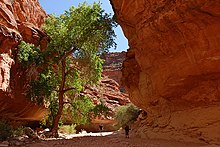
Havasupai Trail is the main trail to Supai, Arizona, and to Havasu Falls. [1] There are other trails, such as the Topocoba, Moqui and Kirby trails. However, these other trails are not maintained. As far back as 1976, they were described as ranging from "in poor repair" to "primitive, dangerous foot trails." [2] Special permission is required to use any such trail. [3]

